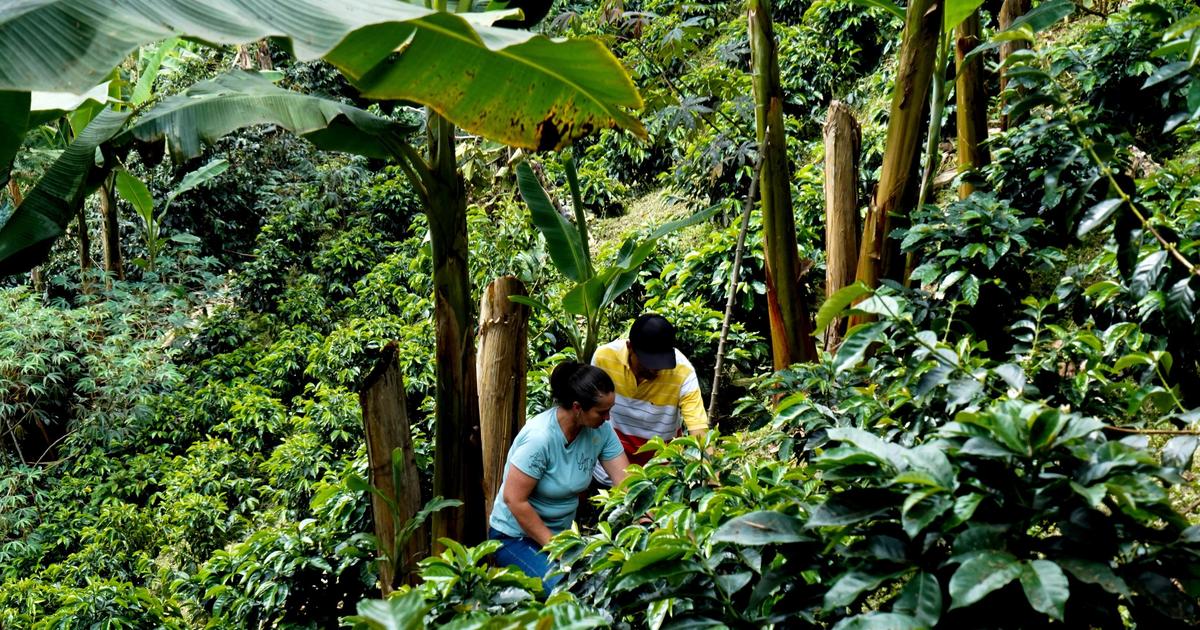The Willys' engine purrs, then growls, as they leave the straight streets of Jardín.
The bright yellow, azure blue and light green bodies of these old Jeeps from the 1980s respond to the colorful facades of the Colombian city of some 14,000 inhabitants, more than 100 kilometers south of Medellín, the country's second largest metropolis.
Jardín, one of the epicenters of coffee culture, is nestled there, in the hollows of the relief, at the foot of the Andes mountain range.
We rush there as soon as we leave the city, on winding roads first paved, then rocky.
All around, the mountain deploys its slopes, its ravines and its curves, spreading out a shades of green.
That of the coffee fields, cultivated at least 1600 meters above sea level, on the mountainside.
The Pacific Ocean, 200 kilometers away, charges the
Read alsoTo live longer, should we drink at least two cups of coffee a day?
After half an hour on the road, Olga Nelly Pareja and Wilson Rojas Mesa, each in their forties, are waiting for us at the entrance to their farm, whose fields flow towards the valley.
"The land has belonged to my family for nearly half a century," Wilson explains in a modest voice, a cap screwed on his head.
I took it over twenty years ago, when my father died, and I had to learn everything.
Olga, also the daughter of coffee growers, with a degree in agronomy, joined him a few years ago.
Originally from a neighboring region, born into a family of twelve children and fatherless very early on, she too had to take over the family farm.
"My sisters and I lacked knowledge and had no one to support us," she says, smiling but her eyes filled with tears.
I felt very alone,
In video, 5 ways to use coffee other than as a drink
The organic scale
Full screen
Farms like Wilson's and Olga's are located in the mountains, near Jardín.
Maurine Pagani
The couple transformed this farm into a sustainable model in the region.
Coffee trees, plantains and fruit trees grow on just under 2.5 hectares, the average area of Colombian coffee farms.
In a greenhouse, a few lettuces, broccoli, carrots and aromatic herbs complete the set.
The farm, certified by the biodiversity protection NGO Rainforest Alliance, operates without pesticides or chemical inputs.
A carpet of leaves, wood and fruit fertilizes the soil, while polyculture protects the land from erosion and provides additional income to the two annual coffee crops.
The coffee cherries, picked by hand, are then pressed on site, at the rate of 250 kg per hour, by a machine capable of separating the pulp from the beans.
"This place was very different in my parents' time," Wilson recalls.
They only grew coffee trees on empty ground above a dead river, because the water was thrown into it without treating it.
Water is in fact used to rid coffee beans of mucilage, the sugar that coats them and which, when fermented, becomes toxic to the aquatic ecosystem.
In addition to having divided by ten the quantity of water needed to clean a kilo of coffee, Olga and Wilson installed a biological treatment station on their farm.
The last link in a farm in an almost closed circuit, which produces its own resources and processes its waste, since the couple joined, in 2010, the AAA program of Nespresso, their client.
The principle ?
Agricultural engineers, employees of the company,
guide coffee growers in their transition to regenerative and efficient, and therefore profitable, agriculture.
"Olga and Wilson are very demanding, working with them is a huge challenge," smiles Raul Fernando Zuluaga, the couple's agronomist, seated on their terrace in front of a
sancocho
, delicious chicken and vegetable broth.
This 30-year-old engineer is one of three agronomists in the region, who accompany the 200 or so AAA farmers in Jardín – there are 9,000 in the department of Antioquia, and 120,000 worldwide.
Awareness
Full screen
Jenny Astrid Grisales Osorio, 34, Nespresso agronomist, visiting one of the cafeterias she accompanies.
Maurine Pagani
In terms of ecology and yield, Colombian coffee growing comes a long way.
For a long time, it functioned without an account book or agronomic register, without a pension fund or insurance in the event of a bad harvest.
Here too, Nespresso strives to act, alongside heavyweights in the sector – the NGO Rainforest Alliance, therefore, but also PUR Projet, by Tristan Lecomte, pioneer of fair trade.
The company contributes to the BEPS, a pension fund also financed by
cafeterias
and the Colombian Ministry of Labour, has set up an insurance system, pays its coffee more than the official rate – €12 more per bag on the day of our report, in May – and pays a premium to AAA-certified coffee growers. .
In Jardín, as elsewhere, Nespresso has also financed the construction of coffee cherry processing plants.
Fertile investments, according to a study conducted jointly by the London and Toulouse School of Economics: Colombian farmers who are members of the AAA program have seen their well-being increase by around 20% in ten years, according to the authors.
All this has a cost: nearly 40 million euros per year for Nespresso, which has just been labeled B Corp (a demanding stamp awarded to responsible companies, editor's note).
The price to pay to keep its customers, increasingly demanding in terms of social and environmental impact, but also to ensure its supply of raw materials.
Without soil conservation or protection of farmers, who will be growing coffee in ten, twenty or thirty years?
And how ?
The green business
Full screen
The coffee cherries, on the right, are harvested twice a year, in spring and autumn: the beans will be extracted, then dried, roasted and ground.
Maurine Pagani
The stakes are high for all of Colombia, the third largest coffee producer in the world and the leading supplier of mild Arabica.
Here, 840,000 hectares of coffee trees support half a million families, who produce more than 12 million 60 kg bags of beans each year.
A national treasure that the Colombians themselves have long ignored, as the priority was to export.
Two generations are today carrying the change.
Today's growers, aged around fifty on average, have come to know and defend the aromas of their coffee.
Their children, meanwhile, transcend the family heritage, precious but often too narrow and uncertain.
With their agronomy or business management diploma in hand, some return to the countryside, diversify their activities,
open coffee-shops… In short, they increase the profitability of the sector, while continuing the green transition initiated by their parents.
As a fair balance between modern management and a return to nature and its laws.
“Look on the palm tree, over there, an eagle”, whispers
doña
Gloria, binoculars on her nose and a headband in her hair.
It is 5:50 a.m. when this sixty-year-old coffee farmer welcomes us to her farm, La Clara.
Before our eyes, tiny melancholy tyrants with gray heads and bright yellow bellies, elegant black and gold orioles, magnificent pale blue tanagers, or even Peruvian cocks of the rock, with bright red plumage, waltz in the dawn.
Trees and flowers have been planted to serve as their refuge, under the leadership of the NGO Selva, which collaborates here with the American University of Cornell.
“This project aims to identify and count the local fauna.
I myself fell in love with birdwatching on my father's farm,” says José Fernando Castaño, ornithologist from Selva.
He and his colleagues travel the farms of
about sixty farmers whom they have trained in the protection of birds.
The opportunity for farmers to develop their farm as a full-fledged ecosystem for birds.
Which, in addition to playing the role of biodiversity indicators, attract tourists to the green fiber, sources of potential income.
The return of the country's children
Carolina Jaramillo, 24, understood this well.
A few years ago, this daughter of coffee growers wanted to try her luck in the city, in Medellín.
"I found myself uncomfortable there, not knowing what I was looking for," she says over a coffee, in the central square of Jardín, her brown curls cascading over her floral blouse.
“I gradually realized, as the pandemic then proved to us, that the campaign was all we had, and that it was worth it.”
Upon her return to Jardín, Carolina followed the same training as
doña
Gloria and imagined, on the land of her parents, an agrotourism offer.
At the same time, she cultivates aromatic plants and mushrooms, does gymnastics or crochet.
“I am my own boss, and I manage my schedule,” she sums up with a smile.
His quest for meaning, comfort and personal fulfillment furiously echoes current aspirations on our side of the Atlantic.
And to the new values carried, in Colombia too, by a generation of young people, especially women.
Full screen
Daughter of coffee growers, Alejandra Angel, 28, a quality expert, ensures that the coffees meet Nespresso's criteria before they are exported.
Maurine Pagani
Gender equality is one of them.
All those encountered during this report say it: coffee has long been a product and a world of men.
Women imposed themselves there only thanks to a perfectly egalitarian education or, conversely, constrained by the death of a father, a husband or a brother.
Those who change the situation do so today with determination… and tact.
“When I started managing men, I changed one rule a week, until I earned their respect,” describes Alejandra Angel, 28, also the daughter of
cafeterias
.
A university graduate, she is a quality expert for Cafexport, which ships Colombian coffee and cocoa abroad.
As a worthy sommelier, Alejandra tastes and analyzes samples to verify that they meet Nespresso's criteria.
All in a shed, in the middle of a gathering of older men.
“Women have always had to take decisions, but I feel that we have recently won the right to make them openly,” she adds.
Perhaps because all the forces count in the face of the emergency: to bring back the children of the country frightened by the arduousness of agricultural work, the low wages and the rise in the price of land.
"We must make our trades known, arouse in young people the love of the production of quality coffees", insists Alejandra.
To bring out a new imagination, fertile and compatible with a gentle life.
"Opportunities may be rarer here than in the city, but the
agriculture is a beautiful profession, dignified and even cool, abounds Carolina.
This is how we will bring young people back: by reminding them that we live in paradise.”





/cloudfront-eu-central-1.images.arcpublishing.com/prisa/3JJD4TKINZEPFLXDOCJAQFGKXE.jpg)

/cloudfront-eu-central-1.images.arcpublishing.com/prisa/4QBBQZRJOFAWLKWBHY4E4XP5XE.jpg)

/cloudfront-eu-central-1.images.arcpublishing.com/prisa/YYFLACLTQBGVXLURCA34LLTDVU.jpg)





